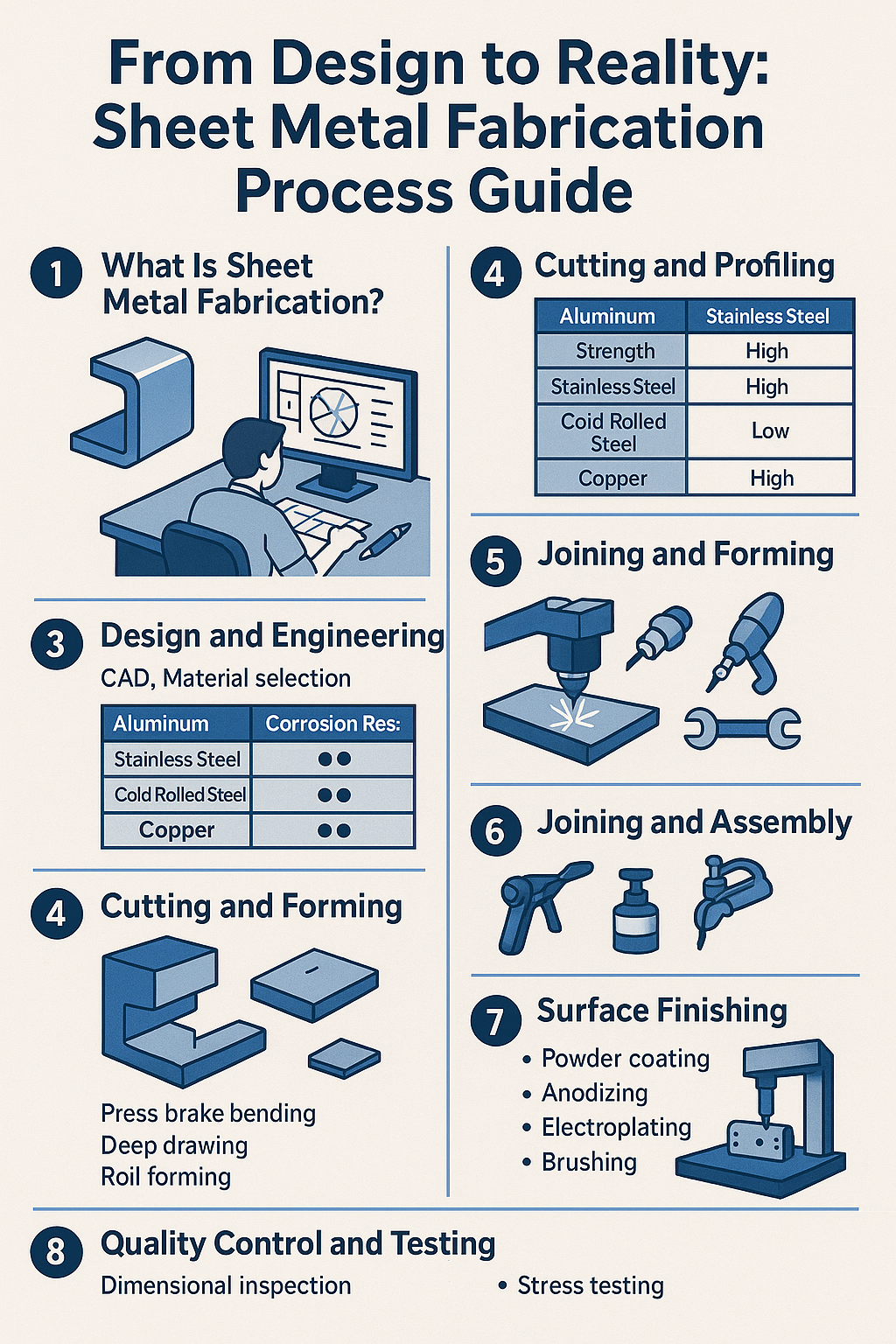
Sheet metal fabrication is the backbone of modern manufacturing, enabling the creation of robust, precise, and functional components for industries ranging from aerospace to consumer electronics. But how does a simple design transform into a fully formed metal part? This comprehensive guide will walk you through the sheet metal fabrication process—from initial design to final production—and show how companies like Boona Prototypes support innovation at every stage.
I. What Is Sheet Metal Fabrication?
Sheet metal fabrication is a manufacturing process used to shape flat metal sheets into specific structures or products. It involves a wide range of techniques, including cutting, bending, forming, welding, and surface finishing. The result? Durable parts used in everything from car frames and HVAC systems to surgical tools and mobile phone casings.
II. Design and Engineering
Every great product starts with a design. Engineers use CAD (Computer-Aided Design) software to model and simulate parts before any metal is cut. This phase involves:
-
Material selection
-
Tolerance planning
-
Design for manufacturability (DFM)
Boona Prototypes offers full CAD modeling support to ensure your design can be cost-effectively translated into real-world parts.
III. Material Selection
Choosing the right material depends on the application, strength requirements, environment, and cost. Common metals used in fabrication include:
| Material | Strength | Corrosion Resistance | Typical Applications |
|---|---|---|---|
| Aluminum | Medium | High | Aerospace, Electronics |
| Stainless Steel | High | High | Medical, Food Processing |
| Cold Rolled Steel | High | Low | Automotive, Construction |
| Copper | Low | High | Electrical Components |
Metal sheets are first cut into desired shapes using a variety of methods. Some common techniques include:
-
Laser Cutting – High precision, low waste
-
Plasma Cutting – Suitable for thicker materials
-
Waterjet Cutting – Cold cutting with no heat distortion
-
CNC Punching – Ideal for repetitive hole patterns
Boona Prototypes utilizes state-of-the-art cutting equipment, ensuring high accuracy and reduced material waste. Visit their sheet metal services page for more details.
V. Bending and Forming
Forming transforms flat metal into 3D shapes. Processes include:
-
Press Brake Bending – Standard method for V-shaped bends
-
Deep Drawing – Used for cylindrical or box-like enclosures
-
Roll Forming – Continuous bending for long sections
Precision in this step is critical to ensure that final parts fit correctly in their assemblies.
VI. Joining and Assembly
After forming, parts are often joined together using:
-
Welding (TIG/MIG)
-
Riveting
-
Adhesive bonding
Boona Prototypes offers full assembly services, helping customers go from components to complete units.
VII. Surface Finishing
Finishing adds both protection and appearance to fabricated parts. Common surface treatments include:
| Finish Type | Purpose | Typical Use Cases |
|---|---|---|
| Powder Coating | Aesthetic + corrosion resistance | Consumer electronics, furniture |
| Anodizing | Surface hardening + aesthetics | Aluminum parts, aerospace |
| Electroplating | Conductivity + anti-corrosion | Electrical components |
| Brushing/Polishing | Smooth finish for visual appeal | Decorative panels |
Explore Boona’s full list of surface finishing options for tailored solutions.
VIII. Quality Control and Testing
Quality assurance is critical in precision manufacturing. Techniques include:
-
Dimensional inspection (CMMs, gauges)
-
Material certification and traceability
-
Stress testing and hardness checks
Boona Prototypes ensures ISO-compliant quality standards for every batch.
IX. Packaging and Delivery
Before shipping, finished products are carefully cleaned, labeled, and packaged using corrosion-resistant materials and shock-proof foam or crates to avoid damage during transport.
X. Advantages of Partnering with Boona Prototypes
By choosing Boona Prototypes, customers benefit from:
-
Fast prototyping and production
-
High-precision machinery
-
Experienced engineering support
-
Scalable solutions from prototype to volume manufacturing
Their one-stop service model makes them a trusted partner for sheet metal fabrication across the globe.
Conclusion
The journey from a CAD drawing to a finished metal part involves multiple precise steps, each of which contributes to the quality and functionality of the final product. Understanding this process helps engineers and businesses make informed decisions about design, materials, and production partners.
If you’re looking for a trusted expert in sheet metal prototyping and fabrication, explore Boona Prototypes to bring your design to life—efficiently, accurately, and affordably.
FAQs
1. What is sheet metal fabrication?
Sheet metal fabrication is the process of turning flat metal sheets into functional parts or assemblies using cutting, bending, welding, and finishing techniques. It’s widely used in automotive, aerospace, electronics, and industrial applications.
2. What materials are commonly used in sheet metal fabrication?
The most commonly used materials include:
-
Aluminum – Lightweight and corrosion-resistant
-
Stainless steel – Durable and rust-resistant
-
Cold rolled steel (CRS) – Strong and cost-effective
-
Copper – Conductive and malleable
Each material is selected based on its mechanical properties and the intended use of the final product.
3. How accurate is CNC sheet metal fabrication?
Modern CNC machines offer extremely high precision, often within ±0.1 mm or tighter, depending on the equipment and part complexity. Boona Prototypes ensures tight tolerances with advanced CNC cutting and forming technology.
4. What is the typical lead time for sheet metal prototyping?
Lead times vary based on part complexity, material availability, and quantity. Simple prototypes may take 3–7 business days, while more complex assemblies may require 2–3 weeks. Boona Prototypes offers rapid turnaround options for urgent projects.
5. Can I order both prototypes and production parts from the same supplier?
Yes. Boona Prototypes provides end-to-end services, from rapid prototyping to low- and mid-volume production, making it easy to scale your project with a single partner.
6. What finishing options are available for sheet metal parts?
Popular finishing options include:
-
Powder coating
-
Anodizing
-
Electroplating
-
Brushing & polishing
These finishes improve corrosion resistance, durability, and aesthetic appearance. Learn more on Boona’s surface finishing options page.
7. What files do I need to provide for fabrication?
You should submit 2D drawings (e.g., DXF, DWG) and 3D CAD files (e.g., STEP, IGES, STL). Make sure to include bend lines, hole placements, tolerances, and material specs.
8. Is there a minimum order quantity (MOQ)?
Boona Prototypes offers low or no MOQ for prototypes and small batches, making it ideal for startups and R&D projects.
9. How can I ensure my design is manufacturable?
Use Design for Manufacturability (DFM) principles—avoid overly tight bends, allow for material spring-back, and maintain consistent thickness. Boona’s engineering team can assist in reviewing your design before fabrication.
10. What industries benefit most from sheet metal fabrication?
Industries that commonly rely on sheet metal fabrication include:
-
Automotive
-
Aerospace
-
Consumer electronics
-
Medical devices
-
Industrial equipment
Boona Prototypes serves clients across all these sectors with custom, high-precision solutions.



